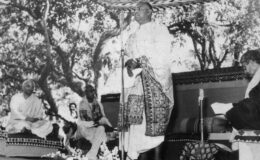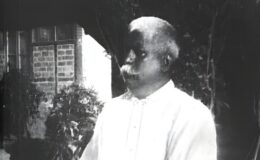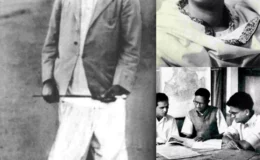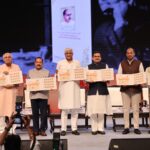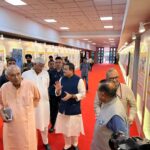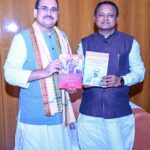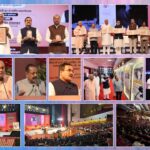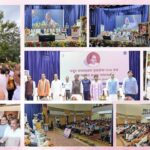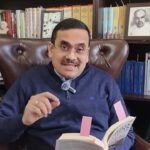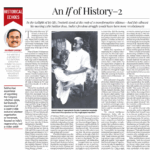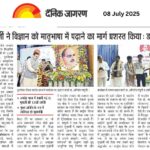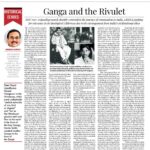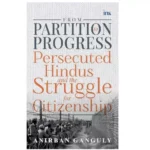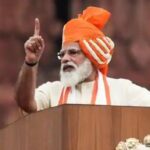WHERE FAITH MEETS NATIONALISM
- By : Anirban Ganguly
- Category : Articles
People in the pre-independence era spoke of weaving of a sense of unity through pilgrimage. But a discourse that has assumed a dominant proportion in the last four decades, with the aid of institutional control, has been preoccupied in debunking this underlying unity
Where political ambition united or divided the country, pilgrimage wrought a unity based on religion, and a faith in certain eternal verities. Long before wise statesmanship attempted or accomplished Indian unification, Akhand Hindustan had sprung from the wandering of pilgrims”, wrote KV Rangaswami Aiyangar in his introduction to Bhatta Lakshmidhara’s Krytakalpataru. The reprint of Bhatta’s work was part of the Baroda Oriental Series that Maharaja Sayajirao Gaekwad of the State of Baroda had initiated in order to reprint and disseminate the classics produced by Hindu civilisation for the benefit of a larger cross section. In an India under colonial rule, such efforts were striking and displayed the foresight that Sayajirao had. The re-discovery, re-interpretation and renewed dissemination of classics, through the medium of India’s many languages, thus, is an essential expression of a civilisational renewal. Some interpret such efforts as re-vitalism, while others see it as an essential characteristic in the process that leads to the rise of a civilisational state.
Aiyangar spoke of the fundamental and yet organic unity of India which the unlettered pilgrim had long internalised and absorbed. For a voluble section, far removed from the ethos and spirit of Indian civilisation, a section which essentially thrives on creating a false narrative of Indian civilisation, Aiyangar’s interpretation would have been read as a hegemonistic display of what is essentially a mindset of dominance and coercion. Some, with political motivation, ignorantly and most often with deliberate intent to confound, conveniently skirt these works and interpretations because in the long run, highlighting these would dilute their political habit of division and of victimhood.
Talking of this weaving of a sense of unity through the institution of pilgrimage — tirtha — a fundamental framework in the evolution of India’s spiritual evolution, historian Radha Kumud Mookerjee, one of the interpreters of India’s fundamental unity — wrote, a hundred years ago, (Fundamental Unity of India, 1914) of how pilgrimage is a “most powerful instrument for developing the geographical sense in the people which enables them to think and feel that India is not a mere congeries of geographical fragments, but a single though immense organism filled with the tide of one strong pulsating life from end on end.” Mookerjee’s work was segregated and discussion on it confined to a certain section.
In a later study, Nationalism in Hindu Culture (1921), Mookerjee again discussed the tradition of pilgrimage and its fundamental objective, “The contemplation of the numerous holy places scattered throughout the vast continent has the inevitable effect of extending the geographical horizon of the unlettered millions…they are thus naturally and automatically led to expand the limits of their original narrow home or the land of their birth, and learn to identify it with a gradually widening area over which they are forced to traverse by religious necessities in search of the holy places scattered throughout it. The institution is thus a most effective agency of popular education in geographical consciousness.”
In between, these two work brought out by Mookerjee, appeared the series by Sri Aurobindo on The Renaissance in India and Other Essays on Indian Culture — for a while popularly known as the ‘Foundations of Indian Culture.’ Sri Aurobindo spoke of “diversity in oneness” — as an essential differentiating fundamental of Indian — read Bharatiya civilisation. The reference thus to one nation and one people — much vilified and falsified — actually recognises this fundamental organic unity. This reference also welcomes variegated expressions and dimensions, and celebrates these innumerable articulations and interpretations. It allocates and allows space to the manifestations of these diversities and discovers and describes an underlying and sustaining unity amidst this pulsating diversity.
A discourse that has assumed a dominant proportion in the last four decades or so, mainly with the aid of institutional control has been preoccupied in debunking this underlying unity rather than trying to celebrate it. In the name of celebrating diversity, this discourse has only stressed on division, in the name of dispassionate research such a discourse has only tried to dilute this sense of oneness, accrued over millennia. Such an intellectual propensity has displayed disdain towards any effort or quest at trying to re-discover or re-state our civilisational identity.
In fact, if one were to recall Charles Trevelyan’s famous quip (in his On the Education of the People of India, 1838) — not as often repeated as Macaulay’s minutes, but equally indicative — with reference to that section of Indians who were eagerly adopting the ways of the new colonial education, “It is only by the infusion of European ideas that a new direction can be given to the national views. The young men, brought up at our seminaries, (schools and colleges in this context) turn to the prospect of improving their national institutions on the English model. Instead of regarding us with dislike, they court our society, and look upon us as their natural protectors and benefactors: The summit of their ambition is, to resemble us; and, under our auspices, they hope to elevate the character of their countrymen.”
It is this section, which has created the greatest disruptions and ruptures in Indian society and in the capacities of the articulate and cited sections among them to effectively interpret their own cultural aspirations, expressions and symbols. Those among this section, who reversed the process of de-culturisation and delved deep into a civilisational self-discovery of India, were the ones who actually stemmed the deracinating tide. But post-independence, educationally and culturally, free India hardly gave them their due, preferring rather to be guided by frameworks that were evolved for other lands and climes. Singing paeans to one party and to one dynasty became the order of the day and commitment to freedom of expression was measured by how loud one professed one’s allegiance to that dynasty and to its representatives.
On the question of a national identity, Pandit Deendayal Upadhyaya, for example, spoke of the need to re-articulate it. Such an identity, argued Upadhyaya, subjected to a deep coercion and misinterpretation because of years of imperialistic domination. One of the conditions for rediscovering and re-stating such an identity was independence and yet independence, he observed, became meaningless if it did not facilitate the description and situation of this identity. Such a state of independence would then by itself become ineffective or incapable of spearheading the path of national progress or of moving ahead in consonance with the “natural bent.”
As Upadhyaya wrote, “It is essential that we think about our national identity. Without this identity there is no meaning of independence, nor can independence become the instrument of progress and happiness. As long as we are unaware of our national identity, we cannot recognise or develop all our potentialities. Under alien rule, this identity is suppressed. That is why nations wish to remain independent so that they can progress according to their natural bent and can experience happiness in their endeavour.” The neglect of this rediscovery of Bharat’s essential self-identity, observed Upadhyaya, was one of the basic causes of the problems facing Bharat.
An era of civilisational regeneration or rise begins when the night of false narratives is sought to be vanquished under the light of a new collective self-confidence. Such a self-confidence attempts to situate Bharat dynamically in the world-space, while seeking to re-discover and articulate her essential civilisational identity. As Tagore observed in his treatise Swadeshi Samaj, “The way to self-preservation is to awaken the power within us and give it direction” and to “become what we actually are — consciously, strongly, and in a dynamic and complete manner.”
Such an era of awakening, as Tagore would say, “of the power within us”, has now irreversibly begun. It would thus be wise to strengthen those who, in this age, lead such a renewal and guard against those who seek to sow seeds of doubt and dissention against such an epochal process. To resist with all one’s intellectual might those who oppose such an evolutionary cycle in India’s history is also one of the cardinal needs of the moment. The adversaries are easy enough to recognise…

